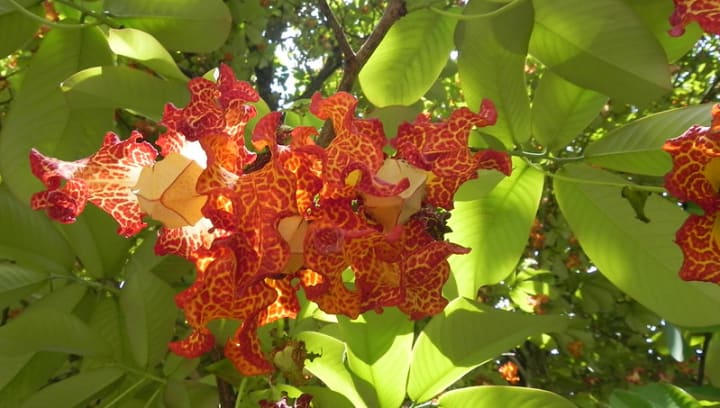Monodora myristica, commonly known as African Nutmeg, Calabash Nutmeg, or Jamaican Nutmeg, is a tropical tree native to Africa that holds a wealth of value in terms of culinary, medicinal, and even industrial uses. With its distinct aroma, multiple uses, and historical significance, Monodora myristica offers a unique glimpse into the world of tropical flora.
Scientific Classification of Monodora myristica:
Kingdom: Plantae
Division: Angiosperms (Flowering plants)
Class: Eudicots
Order: Magnoliales
Family: Annonaceae
Genus: Monodora
Species: Monodora myristica

Monodora myristica belongs to the Annonaceae family, which includes other well-known species such as the soursop and cherimoya. Native to the tropical rainforests of West and Central Africa, this evergreen tree has spread beyond its original habitat and is now found in parts of the Caribbean, Southeast Asia, and the Indian subcontinent.
Often referred to as "African Nutmeg" or "Jamaican Nutmeg," this tree produces seeds that resemble nutmeg in appearance and aroma, though they are from a different botanical family. Despite the similarity, the plant has distinct characteristics that set it apart both in its natural environment and its uses.
Monodora myristica is a large tree that can grow up to 35 meters tall. Its trunk can reach a diameter of 2 meters, with a straight, prominent stem and horizontal branching. The leaves of the tree are alternate, dark green, and elongated, often with a glossy appearance. These leaves play a crucial role in the plant's photosynthesis and are integral to the tree's growth in the dense, humid environment of tropical forests.
Flowers: One of the most distinctive features of Monodora myristica is its large, fragrant flowers. The flowers, which bloom in clusters on new branches, are typically about 20 cm long. Each flower has six petals with red, green, and yellow markings. The flowers are insect-pollinated, and Monodora myristica has a protogynous flowering pattern—meaning the female reproductive organs mature before the male ones, promoting cross-pollination.
Fruit: The fruit of Monodora myristica is a large, spherical berry about 20 cm in diameter. Initially green, the fruit turns woody and hard as it matures. The fruit contains numerous seeds surrounded by a fragrant, white pulp. The seeds, which are about 1.5 cm long, are the most commercially valuable part of the plant.
The seeds of Monodora myristica have a strong, aromatic scent that closely resembles nutmeg, which is why it is often referred to as "African Nutmeg." This aroma is attributed to essential oils present in the seeds, which contain compounds such as α-phellandrene, α-pinene, and limonene. The seeds contain about 5-9% essential oils, which give them their characteristic fragrance and flavor. These oils are used in both culinary and medicinal applications.
The leaves of the plant also contain essential oils, including β-caryophyllene and α-humulene, which contribute to their fragrance and have potential anti-inflammatory properties. These chemical components make Monodora myristica a versatile plant with multiple applications in both traditional medicine and modern research.
In African cuisine, the seeds of Monodora myristica are widely used as a spice, particularly in West African countries such as Nigeria, Ghana, and Liberia. The seeds are dried, ground, and used to add flavor to soups, stews, and various meat dishes. The flavor is often described as a milder version of nutmeg, with a slight peppery and spicy note, making it a versatile addition to savory dishes.
In the Caribbean, the tree was introduced during the 18th century and became a staple in local spice blends. The seeds are also used in some dessert recipes, including cakes and pastries, where their warm, aromatic flavor adds depth to sweet treats.
Traditionally, Monodora myristica has been used in African medicine for a range of ailments. The seeds are believed to have stimulant and digestive properties and are sometimes used to treat headaches, ulcers, and digestive disorders. The tree bark is also used for medicinal purposes, such as treating stomach pain, fever, and hemorrhoids.
Modern studies have begun to explore the potential pharmacological properties of the plant's chemical compounds, especially those found in the essential oils. Preliminary research suggests that these compounds may have anti-inflammatory, antioxidant, and antimicrobial effects, making Monodora myristica an exciting candidate for further study in the field of natural medicine.
The wood of Monodora myristica is hard and durable, making it a valuable material for woodworking. It is used in the construction of buildings, furniture, and fine woodworking. Due to its ease of processing, the wood is particularly sought after in regions where the tree is grown, and its use is an important aspect of local economies.
In addition, the seeds of Monodora myristica are sometimes made into necklaces and other decorative items, thanks to their attractive appearance and pleasant fragrance.
As with many tropical species, the preservation of Monodora myristica is important for maintaining biodiversity in its native habitats. While the tree is not currently under threat, the ongoing loss of tropical rainforests due to deforestation poses a potential risk to its population in the wild. Efforts to conserve the plant and its habitat will be crucial to ensuring that this unique species continues to thrive for generations to come.
Monodora myristica, or African Nutmeg, is more than just a spice—it's a plant with a rich history, a broad array of uses, and great potential for future applications in food, medicine, and industry. Its fragrant seeds, medicinal properties, and durable wood make it an invaluable resource in many tropical regions. As interest in natural, sustainable resources grows, Monodora myristica may continue to captivate both researchers and enthusiasts alike, offering new insights into the wonders of tropical biodiversity.
animal tags: Annonaceae
We created this article in conjunction with AI technology, then made sure it was fact-checked and edited by a Animals Top editor.